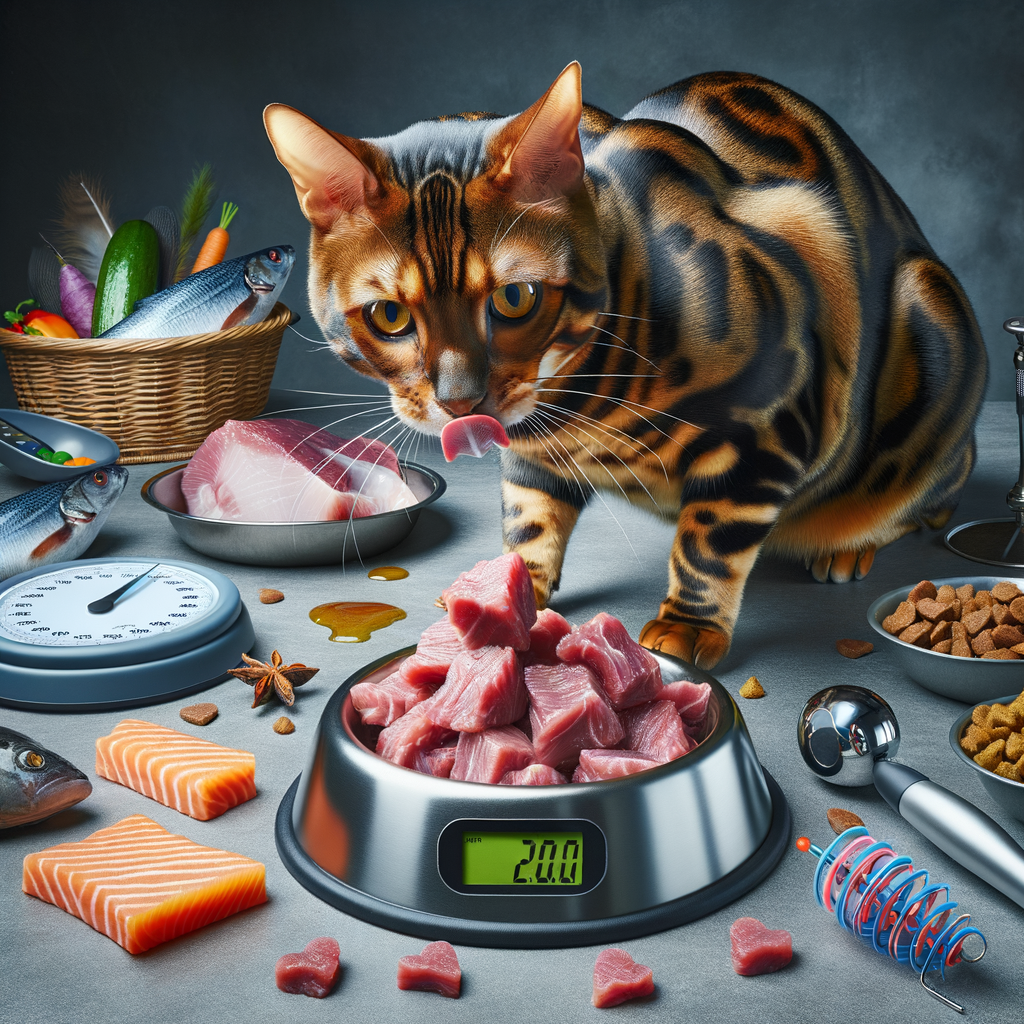
Introduction to Bengal Cat Weight Management
- The importance of weight management for Bengal cats: It helps them live a longer, happier life. Overweight cats can suffer from health problems like diabetes, arthritis, and heart disease. By managing their weight, you can prevent these issues and ensure your cat stays active and playful.
- Identifying the key factors affecting Bengal cat weight: Several factors can influence your Bengal cat’s weight. These include their diet, activity level, age, and genetics. Feeding them the right amount of nutritious food and ensuring they get enough exercise are essential steps. Additionally, regular vet check-ups can help monitor their weight and overall health.
Healthy Weight for Bengal Cats
- Defining the Ideal Weight for Bengal Cats
Bengal cats are known for their sleek, muscular bodies. The ideal weight for a Bengal cat can vary based on age, gender, and overall health. Generally, an adult male Bengal cat should weigh between 10 to 15 pounds (4.5 to 6.8 kg), while an adult female should weigh between 8 to 12 pounds (3.6 to 5.4 kg).
- How to Determine if Your Bengal Cat is at a Healthy Weight
There are several ways to check if your Bengal cat is at a healthy weight:
-
- Feel Their Ribs: You should be able to feel your cat’s ribs without pressing too hard. If you can’t feel them, your cat might be overweight. If the ribs are too prominent, your cat might be underweight.
- Look at Their Waist: When viewed from above, your Bengal cat should have a noticeable waistline. If the waist is not visible, your cat could be overweight.
- Check Their Belly: A small amount of belly fat is normal, but a large hanging belly can be a sign of excess weight.
Bengal Cat Diet and Nutrition
Bengal Cat Diet
- The unique dietary needs of Bengal cats
Bengal cats are active and playful. They need a diet that supports their energy levels. Unlike other cats, Bengals may need more protein. This helps them stay strong and healthy.
Know that Bengal cats can have sensitive stomachs. They might need special food to avoid tummy troubles. Always watch how your Bengal reacts to new foods.
- Choosing the right food for your Bengal cat
When picking food for your Bengal, look for high-quality ingredients. The first ingredient should be meat, like chicken or fish. Avoid foods with too many fillers like corn or wheat.
Here is a table to help you choose the right food:
| Food Type | Benefits |
|---|---|
| Dry Food | Easy to store, helps keep teeth clean |
| Wet Food | More moisture, good for hydration |
| Raw Food | Closest to natural diet, high in protein |
Bengal Cat Nutrition
- Essential nutrients for Bengal cats
| Nutrient | Importance |
|---|---|
| Protein | Helps build muscles and repair tissues |
| Fats | Provides energy and supports cell function |
| Carbohydrates | Offers a quick energy source |
| Vitamins | Supports overall health and immune system |
| Minerals | Essential for bone health and metabolic functions |
| Water | Keeps them hydrated and aids digestion |
-
How to ensure your Bengal cat is getting the right nutrients
- Choose high-quality cat food: Look for brands that list meat as the first ingredient.
- Check the label: Ensure the food meets the AAFCO (Association of American Feed Control Officials) standards.
- Provide fresh water: Always have clean water available for your cat.
- Consult your vet: Regular check-ups can help you adjust your cat’s diet as needed.
Bengal Cat Weight Control
Managing Bengal Cat Obesity
-
Recognizing signs of obesity in Bengal cats
- Excessive weight: A healthy Bengal cat should weigh between 8-15 pounds. If your cat is heavier, it might be overweight.
- Difficulty in movement: Obese cats may struggle to jump or climb.
- Visible fat: You may notice fat deposits, especially around the abdomen and base of the tail.
- Breathing issues: Overweight cats might have trouble breathing, especially during physical activity.
-
Steps for managing Bengal cat obesity
- Consult a vet: Always start by consulting your vet. They can provide a tailored diet and exercise plan.
- Controlled diet: Feed your cat a balanced diet. Avoid high-calorie treats and ensure portion control.
- Regular exercise: Encourage playtime with toys and activities that promote movement.
- Monitor progress: Regularly check your cat’s weight and adjust their diet and exercise plan as needed.
| Age | Weight Range (lbs) |
|---|---|
| Kitten (0-6 months) | 2-6 |
| Young Adult (6-12 months) | 6-10 |
| Adult (1-5 years) | 8-15 |
| Senior (5+ years) | 8-15 |
Weight Loss for Bengal Cats
-
Safe and effective weight loss strategies for Bengal cats
- Balanced Diet: Feed your cat a balanced diet that is low in calories but high in nutrients. Consult your vet for the best diet plan.
- Portion Control: Measure your cat’s food to avoid overfeeding. Use a kitchen scale for accuracy.
- Scheduled Feeding: Stick to a feeding schedule. Avoid free-feeding to control calorie intake.
- Healthy Treats: Give low-calorie treats. Avoid human food and high-calorie snacks.
- Exercise: Engage your cat in regular play. Use toys like laser pointers and feather wands to keep them active.
-
Monitoring weight loss progress in Bengal cats
- Regular Weigh-Ins: Weigh your cat weekly. Use a pet scale for accurate measurements.
- Body Condition Score (BCS): Check your cat’s BCS. This helps you understand if your cat is losing fat and gaining muscle.
- Keep a Journal: Record your cat’s weight, diet, and exercise routine. This helps you track changes over time.
- Vet Check-Ups: Regular visits to the vet ensure your cat’s weight loss is on track and healthy.
| Strategy | Details |
|---|---|
| Balanced Diet | Low-calorie, nutrient-rich food |
| Portion Control | Measure food portions accurately |
| Scheduled Feeding | Stick to a feeding schedule |
| Healthy Treats | Low-calorie treats, avoid human food |
| Exercise | Regular play with toys |
| Regular Weigh-Ins | Weekly weight checks |
| Body Condition Score | Assess fat and muscle changes |
| Keep a Journal | Record weight, diet, and exercise |
| Vet Check-Ups | Regular veterinary visits |
Bengal Cat Feeding Tips
-
How often to feed your Bengal cat
Most experts suggest feeding them twice a day. This helps keep their energy steady and prevents overeating.
Morning and Evening: Give your Bengal cat a meal in the morning and another in the evening. This routine helps them stay active and healthy.
Some Bengal cats might prefer three smaller meals instead. Watch your cat’s behavior and adjust as needed.
-
Portion control and Bengal cat calorie intake
Portion control is key to keeping your Bengal cat at a healthy weight. Overfeeding can lead to obesity, which can cause health problems.
Calorie Needs: An average Bengal cat needs about 20 calories per pound of body weight each day. For example, a 10-pound Bengal cat needs around 200 calories daily.
Use a measuring cup to ensure you are giving the right amount of food. Check the food label for calorie information.
Cat’s Weight (lbs) Daily Calorie Intake 8 lbs 160 calories 10 lbs 200 calories 12 lbs 240 calories
Bengal Cat Exercise Routine
-
Benefits of Regular Exercise for Bengal Cats
- Weight Control: Exercise helps Bengal cats maintain a healthy weight.
- Improved Mood: Active cats are usually happier and less likely to be bored.
- Better Health: Regular activity can prevent health problems like diabetes.
- Stronger Muscles: Exercise keeps their muscles strong and flexible.
-
Fun and Effective Exercise Routines for Bengal Cats
- Interactive Toys: Toys that move or make noise can keep your cat entertained for hours.
- Laser Pointers: Many cats love chasing the light from a laser pointer.
- Climbing Trees: Cat trees or shelves give them a place to climb and explore.
- Fetch: Some Bengal cats enjoy playing fetch with small toys.
- Feather Wands: These toys mimic the movement of birds and can be very engaging.
Maintaining a Healthy Weight for Your Bengal Cat
-
Recap of Bengal cat weight management tips:
- Balanced Diet: Feed your Bengal cat a diet rich in protein and low in carbohydrates.
- Portion Control: Measure food portions to avoid overfeeding.
- Regular Exercise: Engage your cat in daily play sessions to keep them active.
- Monitor Weight: Regularly check your cat’s weight to catch any changes early.
-
Importance of regular vet check-ups for weight management:
- Health Monitoring: Vets can detect early signs of weight-related issues.
- Diet Advice: Your vet can recommend the best diet plan for your Bengal cat.
- Professional Guidance: Regular visits ensure your cat’s weight is managed professionally.
| Tip | Action |
|---|---|
| Balanced Diet | Feed high-protein, low-carb food |
| Portion Control | Measure food portions |
| Regular Exercise | Daily play sessions |
| Monitor Weight | Regular weight checks |
| Vet Check-ups | Regular vet visits |






